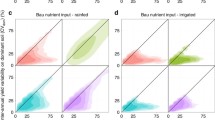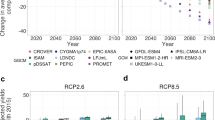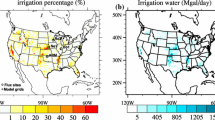Abstract
We assert that the simulation of fine-scale crop growth processes and agronomic adaptive management using coarse-scale climate change scenarios lower confidence in regional estimates of agronomic adaptive potential. Specifically, we ask: 1) are simulated yield responses tolow-resolution climate change, after adaptation (without and with increased atmospheric CO2), significantly different from simulated yield responses tohigh-resolution climate change, after adaptation (without and with increased atmospheric CO2)? and 2) does the scale of the soils information, in addition to the scale of the climate change information, affect yields after adaptation? Equilibrium (1 × CO2 versus 2 × CO2)climate changes are simulated at two different spatial resolutions in the Great Plains using the CSIRO general circulation model (low resolution) and the National Center for Atmospheric Research (NCAR) RegCM2 regional climate model (high resolution). The EPIC crop model is used to simulate the effects of these climate changes; adaptations in EPIC include earlier planting and switch to longer-season cultivars. Adapted yields (without and with additional carbon dioxide) are compared at the different spatial resolutions. Our findings with respect to question 1 suggest adaptation is more effective in most cases when simulated with a higher resolution climate change than its more generalized low resolution equivalent. We are not persuaded that the use of high resolution climate change information provides insights into the direct effects of higher atmospheric CO2 levels on crops beyond what can be obtained with low resolution information. However, this last finding may be partly an artifact of the agriculturally benign CSIRO and RegCM2 climate changes. With respect to question 2, we found that high resolution details of soil characteristics are particularly important to include in adaptation simulations in regions typified by soils with poor water holding capacity.
Similar content being viewed by others
References
Easterling, W. E.: 1996, 'Adapting North American Agriculture to Climate Change in Review', Agric. For. Meteorol. 80, 1–53.
Easterling, W. E.: 1997, 'Why Regional Studies are Needed in the Development of Full-Scale Integrated Assessment Modelling of Flobal Change Processes', Global Environ. Change 7(4), 337–356.
Easterling, W. E., Chen, X., Hays, C. J., Brandle, J., and Zhang, H.: 1996, 'Improving the Validation of Model-Simulated Crop Yield Response to Climate Change: An Application to the EPIC Model', Clim. Res. 6, 263–273.
Easterling, W. E., Crosson, P. R., McKenney, M. S., Katz, L., and Lemon, K.: 1993, 'Agricultural Impacts of and Responses to Climate Change in the Missouri-Iowa-Nebraska-Kansas (MINK) Region', Clim. Change 24, 23–61.
Easterling, W. E., Rosenberg, N. J., McKenney, M. S., Jones, C. A., Dyke, P. T., and Williams, J. R.: 1992a, 'Preparing the Erosion Productivity Impact Calculator (EPIC) Model to Simulate Crop Response to Climate Change and the Direct Effects of CO2', Agric. For. Meteorol. 59, 17–24.
Easterling, W. E., McKenney, M. S., Rosenberg, N. J., and Lemon, K. M.: 1992b, 'Simulations of Crop Responses to Climate Change: Effects with Present Technology and No Adjustments (the “Dumb Farmer Scenario”)', Agric. For. Meteorol. 59, 53–74.
Easterling, W. E., Rosenberg, N. J., Lemon, K. M., and McKenney, M. S.: 1992c, 'Simulations of Crop Responses to Climate Change: Effects with Present Technology and Currently Available Adjustments (the “Smart Farmer Scenario”)', Agric. For. Meteorol. 59, 75–102.
Easterling, W. E., Weiss, A., Hays, C. J., and Mearns, L. O.: 1998, 'Spatial Scales of Climate Information for Simulating Wheat and Maize Productivity: The Case of the U.S. Great Plains', Agric. For. Meteorol. 90, 51–63.
IPCC: 1996, Climate Change 1995: Impacts Adaptations, and Mitigation of Climate Change, Contribution of Working Group II to the Second Assessment Report of the Intergovernmental Panel on Climate Change, Watson, R. T., Zinyowera, M. C., and Moss R. (eds.), Cambridge University Press, Cambridge and New York, p. 880.
Kiniry, J. R., Spanel, D. A., Williams, J. R., and Jones, C. A.: 1990, 'Demonstration and Validation of Crop Grain Yield Simulation by EPIC, EPIC-Erosion Productivity Impact Calculator, 1. Model Documentation', USDA-ARS Tech. Bull. Mo. 1768, 220–234.
Mearns, L. O., Easterling, W., Hays, C., and Marx, D.: 2001, 'Comparison of Agricultural Impacts of Climate Change Calculated from High and Low Resolution Climate Change Scenarios: Part I. The Uncertainty due to Spatial Scale', Clim. Change 51, 131–172.
Mearns, L. O., Macromatis, T., Tsvetsinskaya, E., Hays, C., and Easterling, W.: 1999, 'Comparative Response of EPIC and CERES Crop Models to High and Low Resolution Climate Change Scenarios', J. Geophys. Res. 104(D6), 6623–6646.
Rosenberg, N. J., McKenney, M. S., Easterling, W. E., and Lemon, K. M.: 1992, 'Validation of EPIC Model Simulations of Crop Responses to Current Climate and CO2 Conditions: Comparisons with Census, Expert Judgement and Experimental Plot Data', Agric. For. Meteorol. 59, 35–51.
Rosenzweig, C.: 1989, 'Potential Effects of Climate Change on Agricultural Production in the Great Plains: A Simulation Study', in Smith, J., Tirpak, D. (eds.), The Potential Effects of Global Climate Change on the United States, Vol. 1, Appendix C. Office of Policy, Planning and Evaluation, U.S. Environmental Protection Agency, Washington, D.C., pp. 3-1–3-43.
Rosenzweig C. and Parry: 1994, 'Potential Impact of Climate Change on World Food Supply', Nature 367, 133–138.
Schneider, S. H., Easterling, W., and Mearns, L.: 2000, 'Adaptation: Sensitivity to Natural Variability, Agent Assumptions and Dynamic Climate Changes', Clim. Change 45, 203–221.
Smit, B., McNabb, D., Smithers, J.: 1996, 'Agricultural Adaptation to Climate Variation', Clim. Change 33, 7–29.
Stockle, C. O., Williams, J. R., Rosenberg, N. J., and Jones, C. A.: 1992, 'A Method for Estimating Direct and Climatic Effects of Rising Atmospheric Carbon Dioxide on Growth Yield of Crops: Part I – Modification of the EPIC Model for Climate Change Analysis', Agricultural Systems 38, 225–228.
USDA: 1981, 'Land Resource Regions and Major Land Resource Areas of the United States', U.S. Dep. of Agric., Soil Conser. Serv., Agricultural Handbook 296, Washington, D.C.
USDA: 1994, 'State Soil Geographic (STATSGO) Data Base Data use information', U.S. Dep. of Agric., Soil Conser. Serv., National Soil Survey Center. Misc. Pub. Mo. 1392.
Williams, J. R., Jones, C. A., and Dyke, P. T.: 1984, 'A Modeling Approach to Determining the Relationship between Erosion and Soil Productivity', Trans. ASAE 27, 129–144.
Williams, J. R., Jones, C. A., and Dyke, P. T.: 1990, 'The EPIC Model, EPIC-Erosion/Productivity Impact Calculator, 1. Model Documentation', USDA-ARS Tech. Bull. 1768, 3–92.
Author information
Authors and Affiliations
Rights and permissions
About this article
Cite this article
Easterling, W.E., Mearns, L.O., Hays, C.J. et al. Comparison of Agricultural Impacts of Climate Change Calculated from High and Low Resolution Climate Change Scenarios: Part II. Accounting for Adaptation and CO2 Direct Effects. Climatic Change 51, 173–197 (2001). https://doi.org/10.1023/A:1012267900745
Issue Date:
DOI: https://doi.org/10.1023/A:1012267900745




